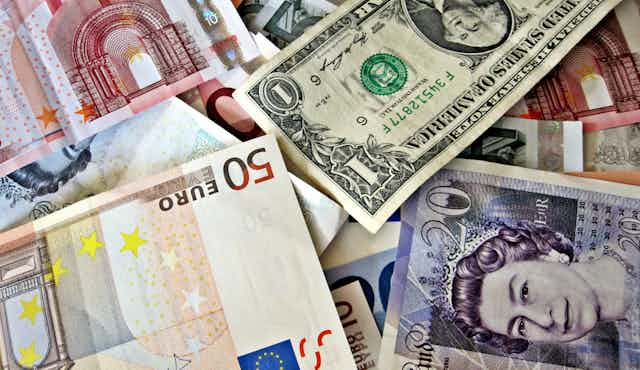Carbon (emissions) taxes have proved unpalatable world-wide, compared to (carbon) emissions trading schemes. But taxes give stable carbon prices while prices in emissions trading schemes yo-yo, plunge, and sometimes do little to cut emissions. In a Nature Climate Change paper out today, Frank Jotzo and I propose a more palatable tax: charge it at a sizeable rate, but only on emissions above fixed thresholds. Emissions would be lowered, but less revenue raised.
The story of carbon tax thresholds starts with the extreme heat and drought of the American summer of 1988, which I well recall living through. It set forests, and also public debate, ablaze. Human-made global warming suddenly became a real problem, demanding real solutions.
In response, environmental economists were soon vigorously promoting a carbon price − a carbon tax or trading scheme − as central to any sensible solution.
Why? Greenhouse gas emissions (“carbon”) come from so many diverse sources: achieving anywhere near the cheapest package of emission cuts with regulations is impossible. Switch coal-fired to gas-fired power generation, or to solar and wind? How about nuclear power? Or use more efficient car engines and home heaters? Maybe even live closer to work, or in less palatial houses?
A high enough carbon price would replace almost all these fraught, intrusive choices by the cost-effective freedoms of a market-based incentive.
But it’s diabolically difficult to get any high carbon price accepted politically. It’s even worse when the price is charged on all emissions coming from any source that’s included in the pricing scheme, as typically assumed for a tax. This can transfer huge revenues to governments, and anything that looks like a government revenue-raising scheme is hard to get past the public.
We propose instead a careful blend of carbon tax thresholds and revenue recycling. Start with a sizeable carbon tax rate, and thresholds - only charge the tax on emissions above thresholds - as generous as needed to keep revenues low enough to be politically acceptable. Recycle the moderate revenues as income tax cuts or rises in welfare payments, especially to help poorer people facing higher energy prices. Later, phase down thresholds, and use the extra revenue to fund business tax cuts and infrastructure investment.
Without thresholds, revenues could be sky-high. We calculate that charging US$50 per tonne of carbon dioxide − roughly what’s needed worldwide to cut emissions as much as scientists recommend − on all current emissions would transfer revenue worth about 12% of current, central government tax revenue in the USA, or 75% in China. Carbon trading with fully auctioned permits at the same price would do the same.
Either would do the job of cutting emissions, but neither will happen any time soon. Concentrated, well-organised, carbon-intensive industries − those most likely to pay the price initially − will [lobby powerfully](http://books.google.com.au/books?hl=en&lr=&id=jv8wTarzmsQC&oi=fnd&pg=PR9&dq=Olson,+M.+The+Logic+of+Collective+Action+(Harvard+Univ.+Press,+1971&ots=m8oKoSSiU1&sig=TSKUNtg0g-fuO-cRpagnjZAIhzg#v=onepage&q=Olson%2C%20M.%20The%20Logic%20of%20Collective%20Action%20(Harvard%20Univ.%20Press%2C%201971&f=false) and successfully, if indirectly, against such transfers.
Recognising this regrettable reality, economists from 1990 onwards stressed how carbon tax revenues could be recycled in useful, popular ways, like lowering income tax rates to lift economic efficiency, and lifting income tax thresholds to lower inequality. They called this “environmental” or “ecological” tax reform, and hoped it would boost support for a carbon tax.
But tellingly, the same idea for recycling carbon trading revenues never had much support. That’s because a politically more effective, if economically less desirable, alternative was obvious to policy-makers.
They could keep a high-ish carbon price, but greatly shrink the permit auction revenue, by keeping the same cap on total tradeable permits. And at first, they would distribute most of the permits for free, in whatever ways might best get the trading scheme accepted politically, if not academically.
Our paper stresses the equivalent, tax-threshold idea: charge a sizeable tax, but only on emissions above thresholds fixed in tonnes per year, and at first distribute these tax thresholds in the same, pragmatic way as free permits. To cut emissions more, a carbon tax needs to raise less revenue!
I first suggested this in 1992, but it’s taken 20 years to see how carbon taxes without thresholds, even with revenue recycling, either don’t get accepted or don’t do much. The great EU carbon/energy tax proposal of the early 1990s had no thresholds, and wasn’t accepted. True, the EU had no power to tax anyway, but the huge revenues that would have been raised didn’t help.
In 11 taxes that were accepted, mostly in Europe, overall tax rates are typically low so they don’t do much to cut emissions. We think the main reason for low tax rates is that any taxed emitters generally pay tax on all their emissions. Better for the environment to recognise some political ceiling on carbon revenue - about 4% of central tax revenue is the highest seen so far - and raise that revenue from a high tax on the last few emissions, not from a low tax on all emissions.
Meanwhile, carbon trading has become the instrument of choice. Trading schemes typically choose to give away most permits free, at least initially. As noted recently by the OECD’s head, politicians recoil from new taxes.
So can our proposal work? To an extent, it already has in Australia. The initial phase of Australia’s carbon pricing scheme works like a carbon tax with thresholds, and money is recycled to poorer households.
Now other countries, including China and Mexico, are preparing carbon taxes. With luck, they will copy the better parts of the Australian scheme (even as the Australian government works to repeal it!) − or try using thresholds.

